- remind me tomorrow
- remind me next week
- never remind me
The X Button
Warriors Born
by Todd Ciolek,

Resident Evil 1.5 is a unique little remnant. Games are often reworked and rebuilt during development, but Capcom did far more when making Resident Evil 2. The original game was supposedly as much as 80 percent complete when the development team, which included both Resident Evil creator Shinji Mikami and future Devil May Cry director Hideki Kamiya, decided that things just weren't up to their standards. The game was tossed aside, and the staff made the Resident Evil 2 that just about everyone liked back in the PlayStation days. The first build was dubbed “Resident Evil 1.5” by fans, and it remains one of the most intriguing pieces of the whole franchise. Canceled games sometimes leak out years after they're declared legally dead, and yet Resident Evil 1.5 quite stubbornly hid itself.
Well, it's not hiding now. A band of enterprising fans found an early version of Resident Evil 1.5, and they're hacking it into properly playable form. Motivated by a sleazy eBayer's attempts to sell their work, the group recently released a sample of the project this week. This rough cut of Resident Evil 1.5 is fraught with the expected glitches and shortcuts, but it shows just where Resident Evil 2 might have gone had Capcom stuck with the original plan.
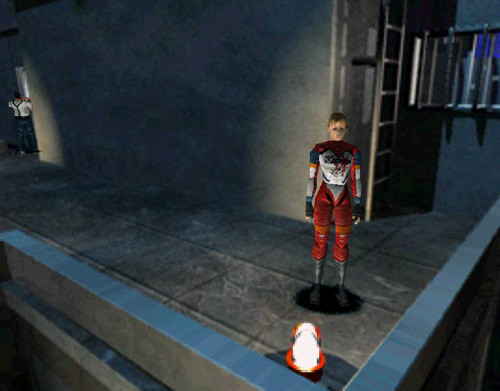
The most obvious change is, of course, Elza Walker. A college student caught up in Raccoon City's zombie outbreak, Elza was playable along with Leon Kennedy in Resident Evil 1.5. Leon made it into the final version of Resident Evil 2, but Elza effectively became Claire Redfield. Nor was she the only alteration. Remember Robert Kendo, the gun store owner who creepily hit on Claire and was devoured by zombies in Resident Evil 2? Well, Resident Evil 1.5 casts him as John, a supporting character who helps Elza throughout the game.
Much of this Resident Evil 1.5 test run seems familiar in the same way. It hints at what we would see in Resident Evil 2, but it's still an entirely different game. It even shows a few apt touches that weren't carried over to its successor. Elza and Leon can equip body armor to noticeable effect, and blood stains their clothes when they're wounded. You may also spot some of the reasons for the game's abandonment; the levels are a bit barren, and there's a lack of cinematic atmosphere. It feels very much like an expanded version of the first Resident Evil's ideas, and I imagine that's part of why Capcom canceled it.
If anything, it makes the real Resident Evil 2 more exceptional. Resident Evil 1.5 is still impressive by the standards of 1997, and it would've done just fine had Capcom released it. But they didn't. Instead, PlayStation owners got a much better sequel, and Resident Evil 1.5 became a fascinating look at roads not taken.
NEWS
KEIJI INAFUNE'S NIECE GOES TO A THEME PARK, AND HER GAME COMES TO AMERICA
Aksys Games clearly isn't afraid of visual novels. The publisher localized Hakuoki: Demon of the Fleeting Blossom last year (more on that below), and they've landed another “otome” title with Sweet Fuse: At Your Side for the PSP. Yes, it's the game where you're the niece of Mega Man mentor and Capcom expatriate Keiji Inafune.
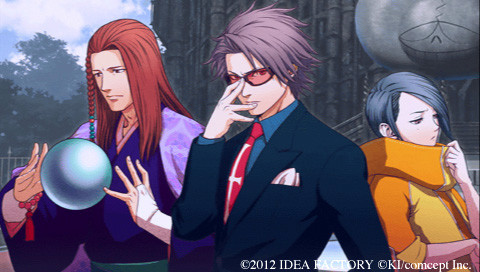
Sweet Fuse finds Saki Inafune, apparently a fictional construct, preparing to visit her non-fictional uncle at an amusement park. The festivities are interrupted by Count Hogstein, a porcine ne'er-do-well who takes over the park and cancels Mega Man games torments the attendees for his own twisted amusement. Saki joins up with numerous handsome strangers to rescue her uncle and, I assume, ensure that Soul Sacrifice, Kaio: King of Pirates, and Inafune's other games ship on time.
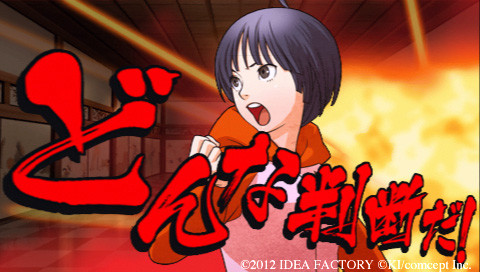
This delightful nonsense is all the work of Idea Factory's Otomate label and (of course) Inafune's Comcept studio. The story progresses in visual-novel fashion, and Saki often faces choices that lead to 14 different endings involving her hunky partners in survival. The game also features puzzles to solve, with Saki striking poses worthy of a Phoenix Wright breakthrough. It's all just crazy enough to work, and it won't take long to prove itself. Aksys fast-tracked it for a summer release.
MARIO & LUIGI DREAM TEAM EXALTS AND ABUSES LUIGI
I'm sure you've all absorbed the news from last week's Nintendo Direct. Donkey Kong Country Returns is coming to the 3DS, and Mario Golf: World Tour and Animal Crossing: New Leaf arrive there this summer. Yet I must give special notice to another scheduled 3DS summer arrival: a new Mario & Luigi title.
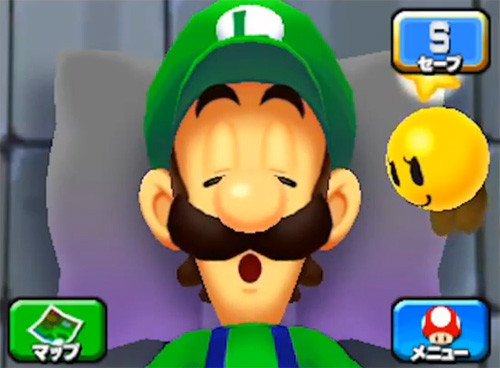
Mario & Luigi: Dream Team exhibits the RPG-platformer habits of its predecessors (which I've always liked a little more than their Paper Mario relatives). The game's levels unfold in Luigi's dreams, and this leads to a rather amusing mechanic. Players poke, prod, and otherwise bother a slumbering Luigi using the lower 3DS panel, and his reactions influence the dream-based gameplay on the upper screen.
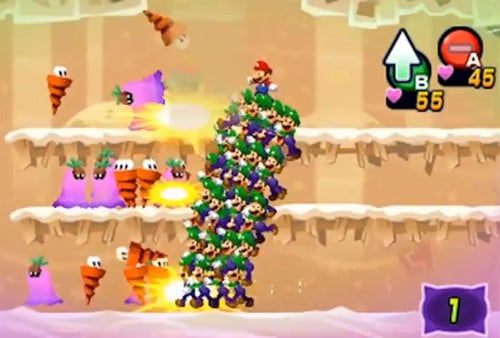
That might also explain the storms of Luigis that aid Mario in his Morphean adventures. Is this all somehow connected to the ending of Super Mario Bros. 2? Probably not, but we won't be sure until later this year.
DRAGON'S CROWN IS STILL AROUND, STILL LOOKIN' NICE
Little was seen of Dragon's Crown in recent months, and that was particularly damaging to such a pretty game. Yet Vanillaware's 2-D brawler is still in the works for the PlayStation 3 and Vita, and Atlus gave it a fresh trailer. Among the sights are a magic carpet, rideable mounts, show-off attacks (note the Amazon's mid-air spin), and a coin-flipping fellow who probably oversees the game's menus. Vanillaware president George Kamitani likes that sort of ornate introduction as much as he likes exaggerating women's physiques.
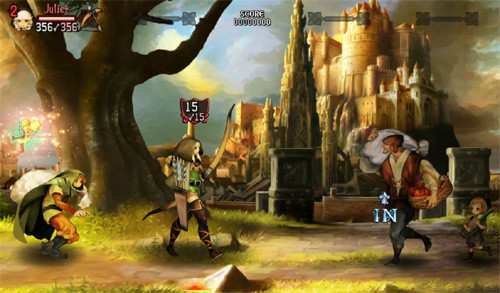
The above screenshot also reveals how Dragon's Crown progresses when not in combat. There are villagers to meet and cities to explore, using the same stage navigation as the Kamitani-helmed Odin Sphere and Princess Crown. Dragon's Crown may have multiplayer action-RPG trappings reminiscent of Capcom's lost-in-legal-limbo Dungeons & Dragons beat-'em-ups, but there's plenty of Vanillaware in it. And I'm not too sure how to take that. Dragon's Crown is gorgeous, but those old Capcom brawlers were comparatively tasteful in their character designs.
INTERVIEW: HAKUOKI'S NORIHISA KOCHIWA AND TSUNEKIYO FUJISAWA
The visual novel wanders a long and often hidden path in Western game markets. Its influence can be seen in the dialogue-propelled flows of the popular Ace Attorney series or the now-forgotten Lux-Pain, but it's uncommon to spot an undiluted example of the genre served up alongside mainstream releases. That's why Hakuoki: Demon of the Fleeting Blossom surprised a few PSP owners when it arrived last year. An ideal example of the “otome” games that target female players, Hakuoki presents a version of the rebellion-ravaged Bakumatsu period mixed with occult elements. It's the tale of one Chizuru Yukimura and her allies in the Shinsengumi, all of whom are handsome and (mostly) charming in the Hakuoki universe. Call it a visual novel, a dating simulator, or a good ol' historical bodice-ripper if you like, but Hakuoki proved one of last year's most unexpected sights.
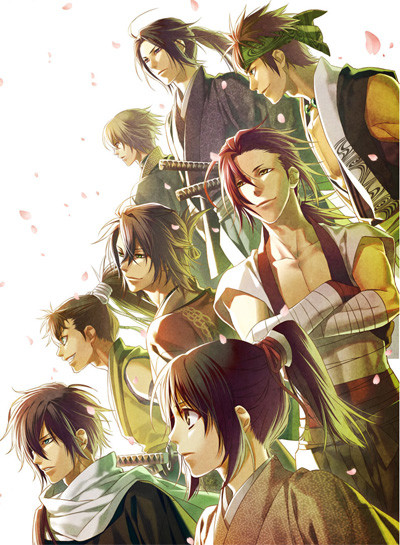
There's more to Hakuoki and its creators than a single game. Demon of the Fleeting Blossom is but one of many similar titles on Idea Factory's Otomate label, which deals in visual novels aimed at women and girls. The developer has dabbled in other genres, including the recent PSP brawler Hakuoki: Warriors of the Shinsengumi. Aksys released the game in North America this week, and so we turned to two of the franchise's key handlers. Norihisa Kochiwa is the producer of the Hakuoki games at Idea Factory and Otomate Studio, and Tsunekiyo Fujisawa handles the series at the company's Design Factory subsidiary.
What was the primary inspiration behind the first Hakuoki game?
Fujisawa: The primary inspiration behind Hakuoki came from the idea “what if murders during the Bakumatsu period were to occur just like how a vampire lusts for blood?” From there, it spawned the story of a man living out his life while maintaining his dignity. Thus, Hakuoki was born.
How did you handle development of an action game like Warriors of the Shinsengumi?
Kochiwa: Development was handled by Idea Factory and Zerodiv. Zerodiv had the know-how to create 3D action games. Furthermore, the fact that they have many female staff members, along with being very familiar with Hakuoki, made them the best partner we could ever ask for. Thanks to them, we were able to develop this game with enthusiasm.
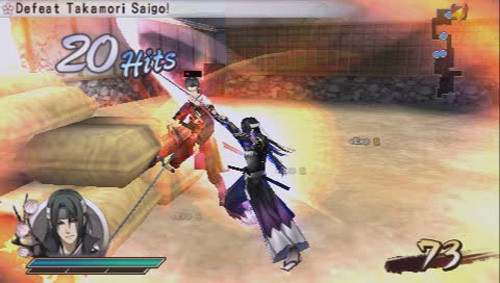
Why did you decide to make a Hakuoki action game like Warriors of the Shinsengumi? Is it aimed at casual players or Dynasty Warriors fans?
Kochiwa: Since we had a lot of fans from the anime version of Hakuoki, we wanted to expand the series away from simply a visual novel. As a result, we ended up going with an action game. Another reason why we developed this title was because there are many female fans that enjoy history-based action games.
It's rare to see a visual-novel "otome" game like Hakuoki released in North America. How do you think the game has done in the U.S.?
Kochiwa: Up until now, visual novel games in the U.S. were not accepted as “games.” The reason why we were able to release Hakuoki in the U.S. is because we had Aksys Games who understood Hakuoki and fans outside of Japan who supported it. As a result, our beautiful illustrations and story got into the users' hands correctly, and we've received great reviews. I would like to express my thanks to those involved, along with the fans.
-How do you balance the historical elements of Hakuoki with the fantasy elements?
Fujisawa: I have written the story so all historical facts and incidents do match up to events that occurred in reality. Within those events, I have added original content such as background stories, things that happened in between those events, stories with furies and stories about the demons. That's why on the outside it's a fantasy that looks like it's based off of historic events.
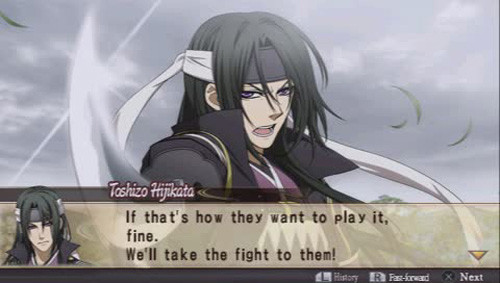
Who is your favorite character in Hakuoki's lineup of Shinsengumi warriors?
Kochiwa: It would be Hajime Saito. I like how he always keeps his cool, and he sticks to his samurai code of chivalry. What I like most is that despite having those characteristics, there's that gap where he sometime has his “airhead” moments and is adorable.
Fujisawa: If I were to choose from the Shinsengumi, it would be Toshizo Hijikata. He never thinks about himself. For his comrades and the organization, he loses his sense of self and turns his heart into a demon so they can all progress as one. I think his nature as a leader is amazing. In addition, towards the end of the story he endures the pressures of being looked up to and depended on. Hijikata grows to be the support for everyone and I think that attitude is tremendous.
How did you come to join Idea Factory?
Kochiwa: When the first generation PlayStation was released, I was attracted to how images were expressed in video games so I strived to get into the gaming industry. Amidst this, I joined Idea Factory who creates such original and creative games. Looking at Idea Factory's website, it seems as though games on the Otomate label make up a lot of the company's current lineup. How do you think the Japanese game market has changed in recent years with regard to female players?
Kochiwa: It's not just our company, but rather the overall count of the otome game titles as a whole has increased, and I feel like there is a lot of hype in the otome market. There are announcements of new releases almost every month and every title has various themes and they are all so attractive.
We strive to respond to the user's demands and create games that exceed expectations, thus stimulating and creating more hype in the otome game market.
On that note, how do you think the market in North America is changing for Japanese visual novels? Will you consider releasing similar games in North America, such as Norn 9?
Kochiwa: Hakuoki was the first time we released an otome title in the U.S. However, the market is still very small, and I do not think it will be an easy path. For Norn 9, I believe the quality of the art and the story will satisfy U.S. consumers. If there are enough voices that request it, we would like to make your wishes come true. Please continue to support us!

One of Idea Factory's upcoming otome games is Princess Arthur [above], which is about the legend of King Arthur. How did that game come about? Was it developed with English-speaking audiences in mind?
Kochiwa: We developed an otome game using the King Arthur legend because there are many female fans in Japan that really enjoy its lore. I believe this is another title that we may possibly consider to be released if there are enough requests for it.
Idea Factory's Lupinus label releases a lot of relationship simulators and "moe" games aimed at male players. How do you think those would do in North America?
Kochiwa: Our moe games, which are aimed at male players, have yet to succeed in foreign countries. The Neptunia series, developed by Compile Heart, is an RPG. I feel like there are many moe fans outside of Japan and I do feel like there is a market for moe games. If we are able to release them outside of Japan, I do feel like the Japanese-style relationship will be a sense of fresh air for people.
NEXT WEEK'S RELEASES
ETRIAN ODDYSSEY IV: LEGENDS OF THE TITAN Developer: Atlus
Developer: Atlus Publisher: Atlus Platform: Nintendo 3DS Release date: February 26 MSRP: $39.99 Did the original Etrian Odyssey jump-start the recent renaissance of dungeon-hack RPGs? Well, it sure didn't hurt. Brimming with tenacious challenges and do-it-yourself maps, it wrapped the old ways of Wizardry and other labyrinthine classics in the cute exaggerations of modern anime design. And it carved out a firm niche among RPG fans. Even as games like 7th Dragon and Unchained Blades arose, Etrian Odyssey and its sequels remained the best place for recruiting a party, plunging into a dungeon, and getting slaughtered if you didn't prepare well enough. Legends of the Titan gained a few more features in bringing Etrian Odyssey to the 3DS. Aside from the new look of the stages and the monsters, the game enjoys an analog camera and a StreetPass character-trading system. There's also a “casual” setting for those who might be put off by the harsh results of a player's party members all perishing. Yet most of those who grab Etrian Odyssey IV will stomp right into the normal mode, where life just isn't fair. They'll embrace the arduous dungeon treks, which unfold in a city right next to the giant tree of Yggdrasil. They'll recruit a party from the game's various classes, including such ranks as the steadfast Fortress knight, the magically damaging Arcanist, and the animal-people samurai called Bushi. And they'll endure numerous first-person battles where positioning and strategy play out turn by turn. It's familiar ground for the series (and most RPGs), but there remains an undeniable charm in the game's mechanics—and in the map that players can sketch out on the 3DS touch screen. Battles and exploration aren't limited to the ground either, as there's an airship…sorry, a skyship to pilot around and customize with such weapons as a monster-baiting Foodapult. Yes, not even the sky is safe when it comes to Etrian Odyssey. |
Ninja Gaiden Sigma 2 Plus arrives on the Vita. Behind that cumbersome title is a port of the PlayStation 3 version of Ninja Gaiden 2, with touch-screen controls, a casual-player mode, and new costumes for Ayane, Rachel, and Momiji.
discuss this in the forum (24 posts) |